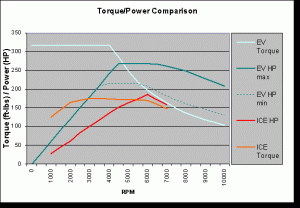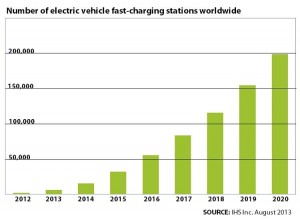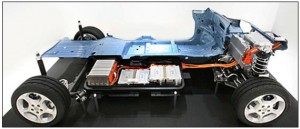Electric Vehicles – Is it worth the switch?
Overview
Pros
- Energy Efficient
- Environmentally Friendly
- Performance Benefits
- Reduced Foreign Energy Dependence
Cons
- Driving Range
- Battery Charge time
- Battery Size, Weight, and Cost
- Limited Existing Infrastructure
Pros – What are the advantages of driving a fully-electric vehicle?
Electric vehicles are Energy Efficient. They convert about 59-62% of electrical energy from the grid into mechanical energy at the wheels. Conventional Internal Combustion Engines (ICE) powered vehicles convert between 17-21% of the energy stored in the gasoline – over three times less than the EV vehicle.
Electric vehicles are Environmentally Friendly. With tailpipe emissions nonexistent, the only environmental air pollutants these vehicles can be deemed responsible for are associated with the power plant emissions emitted during the production of the electricity. Some sources of electricity – such as hydro, nuclear, wind, solar, and geothermal sources – generate no harmful air pollutants. The annual greenhouse gas emission per passenger vehicle, as determined by the U.S. Environmental Protection Agency, is 4.75 metric tons of CO2 per vehicle per year(for information on how this calculation was performed, click here). Switching to an EV vehicle will help drastically decrease this number, and help overcome the environmental injustices associated with CO2 emissions.
Electric vehicles have Performance Benefits over competing technologies. An EV engine is virtually inaudible, leading to a reduction in noise pollution. An electric motor is able to give the EV instantaneous torque, which leads to strong and smooth acceleration. This means the consumer experiences a remarkably quiet, vibration-free, and powerful ride leading to a better driving experience. Figure 1 below depicts a torque-power comparison between an EV and ICE engine powered vehicle. Note that the EV is able to experience instantaneous torque at 0 RPM.

Switching to an EV leads to a Reduction Foreign Energy Dependence. Electric vehicles operate exclusively on electricity, which is a domestically produced energy source. Charging an EV requires nothing more than plugging into the grid, and thus significantly decreases the need for foreign sources of energy.
Cons – What are the drawbacks associated with driving an electric vehicle?
Electric Vehicles have a limited Driving Range. Most EVs have a range between 60-120 miles before needing to recharge – which to most is sufficient for day-to-day driving. However, consumers inclined to go on long journeys might be concerned with the range capability of the EV battery. These driving ranges also vary depending on your driving conditions – consistent rapid acceleration can decrease your range, as well as hot and cold weather conditions.
EV Batteries Have a Significant Charge Time. The typical wall outlet supplies about 120 Volts, which charges the Nissan LEAF – the most popular EV on the market today – to full in about 22 hours. This is known in the EV community as Level 1 charging. While this sounds dreadful, most US consumers would not need a full charge each day. An overnight charge (~9 hours) would provide you with a range of 40 miles each day – significant enough for day-to-day driving for most US drivers. Level 2 charging supplies the vehicle with 240 volts, which is what a typical household oven or electric dryer uses. This level of charging provides a wide range of charging speeds – maxing at around 70 miles of range per hour of charging. Installing one of these at home can run you about $2,000, which could certainly be seen as worth it for some consumers. Even faster than this are the DC fast charging stations. These stations are not something the average consumer would want to install at home, reaching prices of up to $100,000. They are going to start appearing around the country more frequently in the coming years, beginning in the LEAF targeted areas. These stations provide about 240 miles of range per hour of charging, making it convenient to charge your car to full over a lunch break. Figure 2 below depicts the projected growth of fast charging stations globally. If you are curious about charging stations available near you, click here.

To match the power of an ICE vehicle, the EV battery needs to produce between 25 – 40 kWh. This is twice the battery size of a PHEV and 10 times that of an HEV. This means EV Batteries Have a Significant Size, Cost, and Weight associated with them. The battery is not the only capital cost that drives up the price of EVs, the power electronics to manage the battery also make up a large part of the vehicle cost. The Nissan LEAF lithium-ion battery has a driving range of about 100 miles, weighs 272 kg, and makes up a cost of about $15,600. Figure 3 below shows a cutaway of the Nissan LEAF, displaying the battery and power electronics.

Electric Vehicles have a Limited Existing Infrastructure. To make an EV a realistic choice for consumers, there needs to be convenient charging options available. The implementation of charging stations needs to develop before EVs can gain nationwide acceptance as a valid option for transportation. While there is certainly work to do before this can be deemed a resolved issue, it is one of the more robust alternative fuel networks in the nation, boasting over 2,500 stations accessible to the public nationwide. This surpasses the amount of stations supplying propane, natural gas (CNG), and ethanol fuel blend (E85).
If you are considering making the switch to an electric vehicle and would like to compare vehicles side by side, click here
References:
http://www.plugincars.com/electric-cars-pros-and-cons-128637.html
http://www.autotrader.com/research/article/car-tips/208155/electric-cars-benefits-and-disadvantages.jsp
http://www.conserve-energy-future.com/advantages-and-disadvantages-of-electric-cars.php
http://press.ihs.com/press-release/design-supply-chain-media/number-fast-charging-stations-electric-vehicles-set-rise-nea